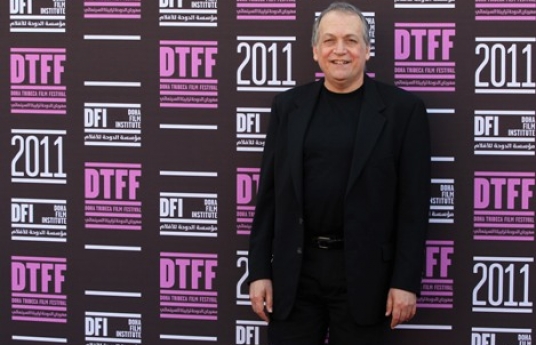Joe Letteri: The Adventures of Tintin: “We Tried to Capture the Spirit that Hergé Drew When We Translated Tintin into a Virtual Character”
Oct 29, 2011 — Film Festival

Award-Winning Senior Visual Effects Supervisor Gives Exclusive behind the Scenes Look at the Making of Tintin
Doha: October 28, 2011: Joe Letteri,senior visual effects supervisor,shared some exclusive clipsin a first behind-the-scenes look at the highly anticipated animated film The Adventures of Tintin, by filmmakers Steven Spielberg and Peter Jackson, at this week’s Doha Tribeca Film Festival’s (DTFF) ‘Doha Talks’ program.
The film, based on a series of classic comic books created by the Belgium artist Georges Rémi who wrote under the pen name Hergé, had its MENA premiere at DTFFas part of Family Day. The film adaptation features the visual effects work of four-time Academy Award and four-time BAFTA winner Joe Letteri, the Senior Visual Effects Supervisor and Director of Weta Digital, the New Zealand based digital visual effects company known for groundbreaking work on The Lord of the Rings Trilogy, King Kong, Avatar and Rise of the Planet of the Apes.
Moderated by Mohammad SaeedHarib, Letteri talked the audience through the creation of the virtual characters of Tintin, Snowy and Captain Haddock by showing rare early drawings, artwork, animation and finished clips from the movie.
Letteri shared the building of the motion capture stage which brought ‘Tintin’ to life, and said at first Spielberg was skeptical about making a non-live action version of the film. However, after Letteri’s team showed Spielberg some early test scenes and characterisations he became convinced that the best way to recreate‘Tintin’was in a fully animated movie.
“For the virtual production we went through the same creative process as we would’ve if it had been a live action film except that we had to build a 3D character in the real world,” explained Letteri. Creating the character of Tintin raised a few difficulties for the effects team, including trying to make Tintin look like a real boy rather than a caricature by capturing actor Jamie Bell’s performance to ensure the audience believed it was really Tintin.
“We had to capture the physical movements of the actors’ body, face and expressions and turn that into a character by mapping it to a Tintin puppet to ensure a believable performance.”
Tintin’s quiff, his round face and his eyes all proved challenges for the production team in terms of creating realism. “We didn’t want Tintin to look like he had a lot of hair products on his hair like he was in a boy band!” jokedLetteri.
The visual effects supervisor also showed early footage put together to create Snowy and Captain Haddock.Due to Hergé’ssparce drawing style, the filmmakers also had to fill in the details to recreate a recognisable but visually realistic world for Tintin including his apartmentand Labrador Road. Like on any live action film, the team behind ‘Tintin’ had to imagine all the scenes.
Letteri said the team worked on the production for four years following initial discussions about the movie that began in 2003. A test on the Avatar stage was completed in 2007 and they shot ‘Tintin’ a year later in 2008, totalingthree to four years of trying to get the production set up and three to four years of hard production.
“We developed the story beats before the dialogue as we didn’t have a script at the beginning so we went back to the books,” explainedLetteri. “It was all very physical and created by looking at the body language in Hergé’s drawings. From those we could see how the relationships between the characters developed and the script was written simultaneously.”
“Hergé worked like a visual effects artist which is why we enjoy his books so much as they are a window on the world. We were really lucky that his estate granted us access to a lot of pictures and original source material which we used as reference in replicating the styles and colours of Tintin’s world to put into the third dimension.”
For more information relating to Festival box office venues, screening locations, transportation or ticket purchases please visit www.dohafilminstitute.com/filmfestival/info or email boxoffice@dohafilminstitute.com
About Doha Film Institute (DFI): The Doha Film Institute (DFI) is an independent cultural organisation established in 2010 to incorporate Qatar’s film initiatives under one banner.
Located at Qatar’s new cultural hub, Katara, DFI’s many initiatives include film and television funding for MENA and international films, year-round education programs, film screenings, and the annual Doha Tribeca Film Festival (DTFF).
In addition, DFI has established a number of strategic cultural partnerships with leading local and international organisations including Katara Cultural Village Foundation, Tribeca Enterprises, World Cinema Foundation, Maisha Film Labs and Giffoni Film Festival.
DFI was founded by H.E Sheikha Al Mayassa bint Hamad bin Khalifa Al-Thani. Along with Her Excellency, DFI leadership comprises DFI Board Vice-Chair and Festival Board Chair, H.E. Sheikh Mohammed Bin Fahad Al-Thani; DFI Board Member and Festival Board Vice-Chair, H.E. Dr. Hassan Al-Nimah; DFI Board Member, Mr. Mansoor Ibrahim Al-Mahmoud; Festival Board Member, H.E. Sheikh Jabor Bin Yousuf Al Thani; and DFI Executive Director, Amanda Palmer.